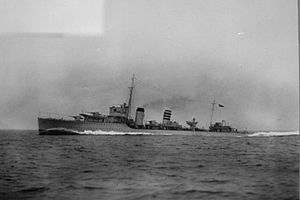 Codrington at sea, 4 June 1930
| |
| History | |
|---|---|
| Name | Codrington |
| Namesake | Admiral Sir Edward Codrington |
| Ordered | 6 March 1928 |
| Builder | Swan Hunter & Wigham Richardson, Wallsend |
| Laid down | 20 June 1928 |
| Launched | 8 August 1929 |
| Commissioned | 4 June 1930 |
| Motto |
|
| Fate | Bombed and sunk, 27 July 1940 |
| Badge | On a Field Silver, a Lion passant Red |
| General characteristics (as built) | |
| Class and type | A-class destroyer flotilla leader |
| Displacement | 1,540 long tons (1,565 t) (standard) |
| Length | 343 ft (104.5 m) |
| Beam | 33 ft 9 in (10.3 m) |
| Draught | 19 ft 9 in (6 m) |
| Installed power |
|
| Propulsion | 2 × shafts; 2 × geared steam turbines |
| Speed | 35 knots (65 km/h; 40 mph) |
| Range | 5,000 nmi (9,300 km; 5,800 mi) at 15 knots (28 km/h; 17 mph) |
| Complement | 185 |
| Armament |
|
HMS Codrington was the flotilla leader for the A-class destroyers built for the Royal Navy (RN) during the 1920s. Completed in 1930, the ship spent most of the 1930s assigned to the Mediterranean Fleet. She helped to enforce the arms embargo imposed on both sides in the Spanish Civil War of 1936–1939. Codrington returned home in early 1937 and was refitted before serving as a training ship in 1938–1939.
During the Second World War she reverted to her designed role, serving in home waters on patrol and convoy escort duties. In early 1940 Codrington played a minor role during the Norwegian campaign and then the German invasion of France and the Low Countries in May. The ship evacuated over 5,000 troops from Dunkirk and other French ports (Operation Cycle and Operation Aerial) before the French surrender of 22 June. She resumed her earlier duties later that month before being bombed and sunk on 27 July at Dover. Her wreck was partially salvaged during the war and completed several years later after the war.